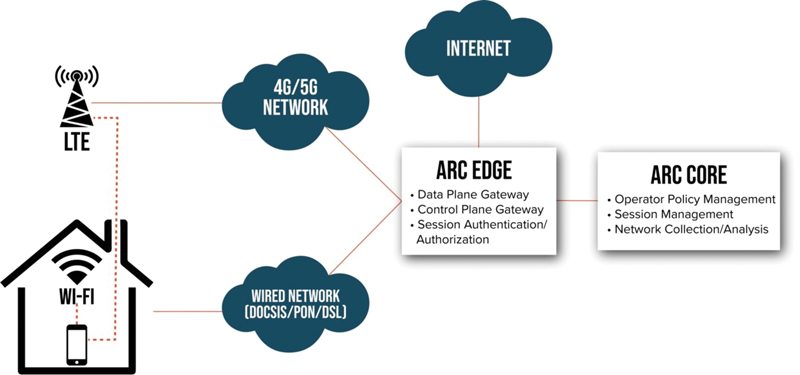Delivering a Better User Experience with True Wi-Fi and Mobile Cooperation
By Dr. Mario Di Dio
In today’s digital world, our mobile devices have become a natural extension of our bodies. No matter where we are, whether in the car, on vacation, at work, out running errands or at home on the couch, we expect continuous connectivity — to everything, everywhere, all the time.
However, despite the fact that we increasingly rely on our mobile devices to improve the ways in which we live, work, learn and play, the reality of wireless communications is not optimal. The world is blanketed by a dense web of overlapping networks, with traffic zipping between provider hubs, Wi-Fi routers, cell phone towers and more than nine billion mobile devices. But having access to multiple connectivity options doesn’t always result in a better user experience.
As users move between intersecting Wi-Fi access points and LTE/5G cellular coverage, they often struggle to maintain acceptable network performance. From dropped calls to video content that simply won’t load, sudden disruptions in network performance often prompt users to turn off Wi-Fi and manually troubleshoot their connection, creating a frustrating hassle for users and potentially significant incremental costs for operators.
Operators are investing billions of dollars in network infrastructure to increase coverage and capacity. Unfortunately, in the event of poor network performance, users default to the path of least resistance, increasingly relying only on the comparatively expensive cellular network for connectivity. Not only does this increase the cost of serving traffic versus other wired and wireless technologies (e.g., DOCSIS, fiber and Wi-Fi), it also potentially strains the cellular network. And while service providers often have limited control over which traffic gets routed where, they tend to be blamed when different access networks don’t cooperate and work together.
With users becoming more aware of connectivity attributes like throughput, latency, reliability and security, the time to address uncontrolled network experiences is now.
If only there were a solution that empowered operators to take control over which traffic is routed over Wi-Fi or cellular.
A solution exists, but there are obstacles to overcome
In order for multiple networks to cooperate, several technology challenges had to be tackled.
- Estimating network performance
First, choosing the best network is tricky, especially if service providers need to do so quickly and efficiently. To realize optimal routing, rapid and effective network performance estimation is necessary, but optimizing routing without coordination or input from core networks is even more challenging from a technology standpoint.
- Realizing application type specific routing
The second challenge is to perform accurate and fast application type classification without any deep packet inspection (DPI). To identify data flows that belong to a certain application type and apply routing policies that are unique for each application type, application type classification is crucial.
- Providing seamless network switching
When a network starts performing poorly, operators need to move traffic to another network — and do so without the end user even noticing, which is difficult to do well.
- Gaining efficiency and scalability
Efficiency and scalability are necessary for gaining and retaining user adoption. To that end, the solution needs to avoid consuming too much of the device’s battery life and network capacity while simultaneously creating efficient and economically scalable client and server implementations.
- Ensuring operator control and monitoring
With all of the previous solutions in this space giving control to the device operating system vendor, or to the mobile core software vendor, operators have little control over which traffic gets routed where. Consequently, network operators cannot provide a predictable customer experience at a predictable cost. But even with a lean solution that addresses the four obstacles outlined above, delivering full control of the user experience to the operator is hard because operators need to monitor system performance to adjust their policies, and they need to control costs while delivering the optimal user experience.

Moving from coexistence to cooperation
Cellular technologies and Wi-Fi technologies have had a very similar but also very different evolution. The technologies were initially created for different use cases, but they started to coexist in mobile devices over time to provide multiple ways for users to connect to the Internet. Now, the challenge is moving from a concept of coexistence to cooperation between cellular and Wi-Fi technologies and ecosystems.
While standards bodies have tried to create cooperation with solutions like LTE-WLAN aggregation (LWA), LTE-WLAN radio-level integration with IP security tunnel (LWIP) and access traffic steering, switching and splitting (ATSSS), the industry has not yet reached network convergence. There are also user-centric software-based solutions that perform link aggregation, but they offer very limited operator control and do not perform routing by application type.
Sure, these solutions are moving the needle in the right direction, but no single solution has overcome all of the obstacles mentioned in this piece to deliver cooperation — until now. Enter adaptive route control (ARC).
How ARC helps
ARC is an intelligent traffic routing solution that uses crowdsourced network-probing algorithms to identify the best network per user and per application type in real time.
Based on a client-server architecture (Fig. 1) where clients are installed on mobile phones and gateways and connect to a cloud-based server, ARC leverages passive and active classification algorithms to categorize traffic and ensure optimal routing. By implementing operator-based policy management, ARC enables operators to control how they shape the user experience in the face of ever-changing network conditions — without needing to perform complex integration or update their 4G/5G core or Wi-Fi access points.
By updating its traffic-routing policies in real time as network conditions change and instantly routing traffic from one network to another without any service interruption — and without users even noticing — ARC creates seamless connectivity and session continuity. Designed for efficiency in terms of battery consumption and data overhead, the ARC mobile client SDK is easy to integrate into the provider’s customer care app (both Android and iOS). Plus, operators can define routing policies based on application or application type, product offering, service tier, or application throughput requirements, thereby creating policies that are aligned with their business objectives while guaranteeing the best user experience for their customers.
Perhaps best of all, ARC is also ready for the future of traffic management. As a converged multiaccess technology for both mobile- and fixed-network traffic, ARC accommodates gateway and home router integration. The solution also addresses 5G ATSSS integration and will seamlessly integrate with 3GPP standards-based mobile device implementations when they become available.
By finally giving control back to operators, ARC empowers providers to route traffic to lower-cost networks and achieve the most efficient utilization of deployed wireless assets, and it optimizes the customer experience, alleviating user frustrations associated with poor Wi-Fi experiences. With ARC, users have a seamless connectivity experience when transitioning between networks, and operators can both realize significant cost savings and gain control over the user experience.

Dr. Mario Di Dio,
VP of Software and Network Technology,
Kyrio
Dr. Mario Di Dio is VP of Software and Network Technology at Kyrio, a wholly owned subsidiary of CableLabs focused on delivering solutions that support operators and their suppliers in building stronger networks through custom services, products and technology solutions that move communications forward. His focus is on products that are related to a range of communication standards (DOCSIS® technology, LTE, 5G, Wi-Fi) that aim to change and augment the way end users experience their network connectivity, while offering operators opportunities for increased efficiency and reliability..


